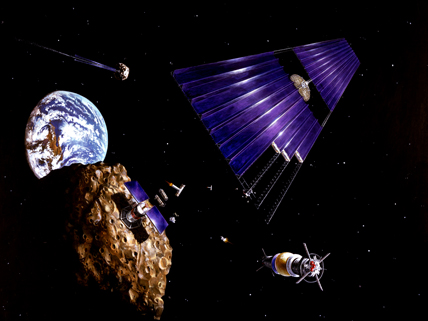An artist’s view of an asteroid-mining mission
On February 15, the asteroid known as 2012 DA14 flew within 17,100 miles of our planet. Just a few hours earlier, a much smaller chunk of space stuff streaked through the atmosphere over Russia. Shortly thereafter, many Russians began searching for remnants from the crash to sell for oodles of rubles on the Internet. In the future, asteroids and other near-Earth objects, such as defunct comet cores, may provide far more income. Asteroid mining may someday become big business.
Earth is running low on key elements needed for our industrial lifestyle. But above us float asteroids containing huge quantities of iron, nickel, platinum, cobalt, and titanium, among other minerals. A metallic asteroid less than a mile in diameter might contain $20 trillion in industrial and precious metals. Asteroids also harbor water, oxygen, and hydrogen—all of which could sustain prospector-astronauts as they search for the minerals. The volatile gases could also fuel rockets—either for further space exploration or for transportation between the asteroids and Earth.
Using these materials on the asteroids themselves would be more cost-effective than bringing them down to Earth. In addition, to keep human beings on the asteroids for any length of time would exceed our capabilities, so it is likely that robotics would be key. For example, robots could mine an asteroid for gold, which could then be used in automated microprocessor production in a zero-gravity environment.
Billionaire entrepreneurs are already forming companies to exploit asteroid resources. However, many scientists do not see the plans as feasible. They cite the figure for an upcoming NASA mission scheduled to return just two ounces of asteroid material to Earth—a cost of about $1 billion. Economists have also weighed in on the concept. They point out that bringing vast quantities of precious minerals back to Earth would cause the formerly rare minerals’ prices to plummet—as the law of supply and demand dictates—making asteroid mining an expensive boondoggle.
Image credit: © NASA/Denise Watt
Related Links
-
How Asteroids Can Save Mankind
This website has vivid graphics that illustrate the significance of asteroid mining.
(Source: 911 Metallurgist; accessed February 28, 2013) -
Moon, Mars, Asteroids—Where to Go First for Resources?
Watch a panel discussion held during the Space Studies Institute’s Space Manufacturing 14 conference in Silicon Valley.
(Source: Space Studies Institute, January 30, 2011) -
Asteroid Mining Venture Unveiled
Watch a video about efforts by two companies—Deep Space Industries and Planetary Resources—to cash in on asteroid mining.
(Source: CNN, January 24, 2013) -
While You Were Working: An Asteroid Just Flew By
Learn all about 2012 DA14, the asteroid that came close to Earth in mid-February, along with several close-up photos of asteroids.
(Source: CNN, February 15, 2013)





I would make a robot that stays on the asteroid and drills for the material then have it launch off back to earth in maybe 10 years for creating it and another 10 years for it to launch and come back.